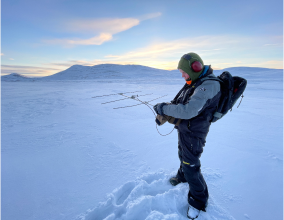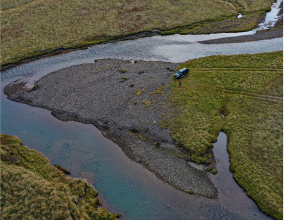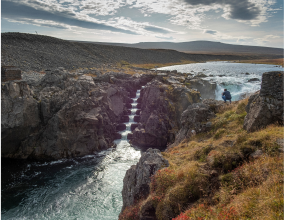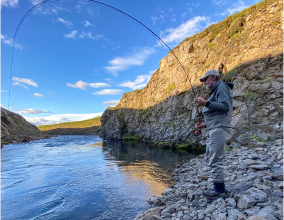ONE OF THE MANY SAPLINGS PLANTED IN VOPNAJFORDUR THIS SUMMER.
This summer, about 10,000 plants have been planted in connection with the Six Rivers Project’s reforestation effort in North East Iceland. The planting is part of Six Rivers’ extensive development, protection, and research work to support and protect the Icelandic salmon.
The project calls for both human resources and significant investment, and its long-term goal is to increase food resources for young salmon in the rivers by introducing more bioactivity into the ecosystem.
The project began last year under the guidance of forester Else Möller. Experimental planting took place, and a plan was made for planting in the coming years. According to Helgi Þorsteinsson, a guide and farmer at Ytra Nýpi in Vopnafjörður, who has taken over as project manager, the work is done according to Else’s plan, while still taking into account the situation at hand, such as access to plants.
“When we set out, there was some plant scarcity in the country. Still, we found the plants needed here and there and have now planted about 10 thousand plants,” Helgi says. More than half of the planting this summer is birch. The rest is a blend of European rowan, tea-leaved willow, woolly willow and alder, as well as experiments with elm.
“There have been five of us working on the planting this summer,” Helgi says. In addition to him a foreman was hired and three young people, aged 16 to 18 years old. He says the work’s continued focus is on native species. “And although elm is strictly not a domestic species, it is closely related to birch. Besides, fossil remains of elm have been found here since before the ice age.”
The project calls for both human resources and significant investment, and its long-term goal is to increase food resources for young salmon in the rivers by introducing more bioactivity into the ecosystem.
The project began last year under the guidance of forester Else Möller. Experimental planting took place, and a plan was made for planting in the coming years. According to Helgi Þorsteinsson, a guide and farmer at Ytra Nýpi in Vopnafjörður, who has taken over as project manager, the work is done according to Else’s plan, while still taking into account the situation at hand, such as access to plants.
“When we set out, there was some plant scarcity in the country. Still, we found the plants needed here and there and have now planted about 10 thousand plants,” Helgi says. More than half of the planting this summer is birch. The rest is a blend of European rowan, tea-leaved willow, woolly willow and alder, as well as experiments with elm.
“There have been five of us working on the planting this summer,” Helgi says. In addition to him a foreman was hired and three young people, aged 16 to 18 years old. He says the work’s continued focus is on native species. “And although elm is strictly not a domestic species, it is closely related to birch. Besides, fossil remains of elm have been found here since before the ice age.”
PART OF THE TEAM THAT HAS BEEN WORKING ON PLANTING IN VOPNAFJÖRÐUR THIS SUMMER. HELGI ÞORSTEINSSON IS AT THE FRONT.
Vegetation restoration and planting is an important activity that increases soil quality in areas of soil erosion and enriches the area’s ecosystem. The hope is that the reforestation will improve the long-term food supply of juvenile salmon in the rivers. However, the results of the experiment will not be known until many years and even decades, reflecting the long-term thinking of the Six Rivers Project. The approach, to protect and restore the quality of the ecosystems, also relies on farmers’ continued cultivation and traditional farming of the land, enriching the quality of the habitats along the rivers.
“Although the status of salmon stocks in Iceland at first glance seems good compared to other countries, the conclusion cannot be that action to support salmon, globally classified as an endangered species, is not needed. The measures that have been taken here have helped to keep it from disappearing, as ever fewer fish return to the rivers from the sea. Egg-planting, salmon ladders and other measures have supported the stock size of our rivers, but the decline calls for action. And If we do not act now, we run the risk of losing the species,” says Gísli Ásgeirsson, Strengur Angling Club’s managing director.
“Although the status of salmon stocks in Iceland at first glance seems good compared to other countries, the conclusion cannot be that action to support salmon, globally classified as an endangered species, is not needed. The measures that have been taken here have helped to keep it from disappearing, as ever fewer fish return to the rivers from the sea. Egg-planting, salmon ladders and other measures have supported the stock size of our rivers, but the decline calls for action. And If we do not act now, we run the risk of losing the species,” says Gísli Ásgeirsson, Strengur Angling Club’s managing director.



